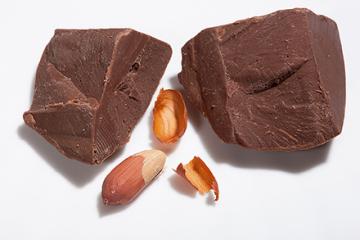A Healthier Milk Chocolate? Yes, Please!

An ARS-developed peanut skin extract helps to fortify milk chocolate without affecting flavor or texture. (Photo by Peggy Greb, D3715-1)
September 13 is International Chocolate Day! What better time to enjoy one of our most beloved treats. Chocolate is as versatile as it is tasty, and you may already be aware of the health benefits of cocoa, and in particular, dark chocolate. The health benefits of cocoa, and in particular dark chocolate, are well documented. Dark chocolate is healthier than milk chocolate because it contains more cocoa solids and therefore has more antioxidants (called flavanols), which may promote cardiovascular health.
But did you know ARS researchers at the Food Science and Market Quality and Handling Research Unit (FSMQHRU) in Raleigh, NC, are developing a healthier milk chocolate?
ARS food technologist Lisa Dean and her team at FSMQHRU are using peanut skins to fortify milk chocolate, thereby increasing the chocolate’s antioxidant levels. Peanut skins contain phenolic compounds including procyanidins which have been shown to reduce inflammation and act as natural antioxidants and antimicrobials.
Unfortunately, peanut skins are very high in tannins, which give them a bitter taste, so skins are usually removed in processing during blanching or dry roasting. Because 50 percent or more of the peanuts grown in the United States are made into peanut butter, all of those removed skins are a major source of processing waste for the industry. Peanut skins can be used in animal feed, but the levels have to be low to keep the animals from rejecting the feed. This leaves the peanut industry with a large amount of peanut skin waste with little to no commercial value.
Dean and her team discovered that some of the phenolic compounds contained in the skins are the same catechins that are in tea, cranberries, and cocoa, and provide health benefits such as antioxidant activity and anti-inflammatory properties. But how do you capture the valuable phenolic compounds for valued-added uses?
Since the ARS research unit is located in the Food, Bioprocessing and Nutrition Sciences Department at North Carolina State University, they were able to have a group of students in a Senior Design class develop a way to combine the soluble extracts with maltodextrin, a starch-based polysaccharide, to make a free-flowing powder that was easier to handle and would control the bitterness.
The resulting powder could then be used as a functional food ingredient, albeit, with the caution that the allergenicity of peanuts carries over to peanut skins. (Therefore, any product using the powder derived from the skins would have to report peanut allergy information on the label.) ARS researchers looked for possibilities to use the value-added ingredient in a way that consumers would associate with peanuts. Well, what pairs better with peanuts than chocolate?
"The phenolic compounds in cocoa are the reason for the health benefits attributed to dark chocolate, but they are also why dark chocolate is bitter. If you have ever tried one of the dark chocolate bars that are very high in cocoa (over 80%) you may have found it tasted more like tobacco than chocolate. Also, because dark chocolate contains less cocoa fat, it is brittle and does not melt smoothly," said Dean These are a few of the reasons why people often prefer milk chocolate over dark chocolate.
With this in mind, ARS researchers decided to investigate the possibility of increasing the antioxidant levels in milk chocolate to those found in dark chocolate.
Working with the ARS team, a graduate student prepared a series of milk chocolate squares containing increasing levels of the peanut skin powder. These chocolate squares were used in a threshold test during which a group of 100 consumers tasted the fortified squares along with some that did not contain any of the peanut skin ingredient. What Dean’s group discovered was that most consumers could not tell if there was an additive in the chocolate until the level of the peanut skins was well above the level that had antioxidant activity equal to dark chocolate.
In a separate study, ARS researchers also used the peanut skin additive to make flavored coatings—honey roasted, chocolate-covered, and chili lime—for peanuts. Phenolic compounds were extracted from peanuts skins and then combined with 10.5% maltodextrin. Various concentrations of the extract were added to the flavored coatings on roasted peanuts. The scientists found that combining peanut skin extract with maltodextrin allowed the peanut skin extract to be added at a high enough level to increase the antioxidant activity without a detectable bitter taste.
Dean’s research constitutes another important example in creating value-added products from food waste. There are a number of food waste products—including coffee grounds and fruit peels—that contain these polyphenol compounds, which could be extracted and processed to make functional food ingredients, including healthier chocolates.
And what better way to celebrate International Chocolate Day than sink your sweet tooth into a healthier milk chocolate bar! — By Nancy Vanatta, ARS Office of Communications.
You May Also Like

